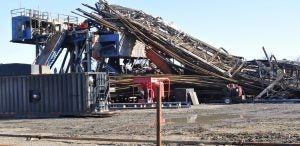 There are nearly a million active oil and gas wells in the United States, and if not correctly designed and maintained, they can leak harmful substances that will irreversibly pollute our land, air and water.
There are nearly a million active oil and gas wells in the United States, and if not correctly designed and maintained, they can leak harmful substances that will irreversibly pollute our land, air and water.
A new study published in the Proceedings of the National Academy of Sciences looked at data from over 100,000 wells and estimates that at least 14% experienced some loss of integrity, which could indicate a leak.
The study’s authors were able to determine the functionality and health of these wells based on data collected from annular pressure tests. In fact, the study analyzed almost 500,000 pressure tests conducted across three different basins — one of the largest studies of well integrity conducted to date.
Analyzing data from these pressure tests is one of the fastest, cheapest and most reliable methods we have to determine whether a well is at risk of leaking toxic or explosive substances. During these tests, a gauge attached to a valve at the wellhead provides a pressure reading of the steel pipes that run underground. Conducting these tests regularly, and noting any changes in pressure, can signal that there is a problem happening beneath the surface.
Annular pressure monitoring and testing makes for safer wells Share on XUnfortunately, in many places the practice of monitoring well pressure is the exception and not the rule. This new study was only able to analyze data from Colorado, New Mexico and Pennsylvania — the only states that substantively require this type of pressure monitoring. Meaning we still don’t know the condition of 90% of the other wells across the country.
Colorado is at the forefront when it comes to requiring these sorts of checkups for wells. Last year, on EDF’s suggestion and with support from industry and the environmental community, it created a new regulation that requires operators to conduct these observations monthly for the entire lifecycle of every well in the state. Operators have to report any problematic readings to the state for review. Additionally, on an annual basis, a more substantial annular pressure test is required.
This process allows Colorado to respond rapidly to problematic wells before a major disaster can occur. Other states have some rules regarding annular pressure, but nothing quite as substantive as monthly monitoring.
- Pennsylvania, for example, has regular mechanical integrity assessments that may include annular pressure monitoring, but not always.
- New Mexico has a variety of field rules requiring annular pressure monitoring, but only in certain regions.
- Texas has a longstanding rule requiring annular pressure monitoring, but it is largely unenforced, with minimal data collection.
- California has a very limited rule that applies solely to hydraulically fractured wells, which make up only a small fraction of the state’s total.
Understanding annular pressure is the best tool we have to understand the health of oil and gas wells and their potential threats to health, safety and the environment. If necessary, wells with annular pressure problems can be remediated or plugged to prevent problematic leakage. Additionally, the data collected from annular pressure tests can identify individual problematic wells and systemic issues across fields, which would call attention to the need for a rule change or a field order. And on a broad scale, annular pressure data provides regulators with insights into how to reduce leakage in the future through zonal isolation, proper surface casing depth and other engineering changes.
For these reasons, regular annular pressure monitoring ought to be incorporated into state well integrity rules. There is no better way to ensure that wells are not contaminating our environment.
Jim Bolander and Jenna Graham contributed to this blog post.









